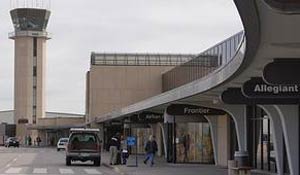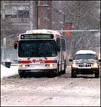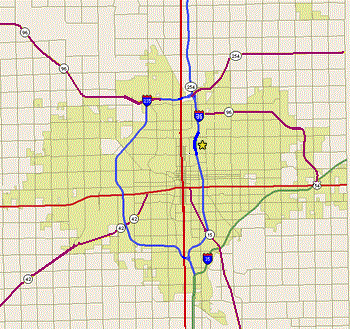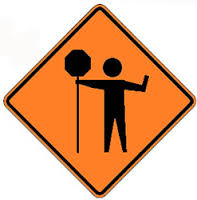 TRANSPORTATION in WICHITA
TRANSPORTATION in WICHITA
NOTE: Except as noted, these comments are the opinions, perceptions or recollections of the author. No guarantee of accuracy is made; however a reasonable effort has been made to realistically reflect the author's life-long familiarity and involvement with the community.
|
This section provides basic & incidental information on various Wichita-area modes of transportation. It is not intended to be comprehensive, but to provide useful information. Some information is simply links to other sources.
Transportation is one of the chief factors affecting the function and life of a city. Transportation largely shapes city politics and culture, and vice versa.
TRANSIT: Of particular interest, under the subject "PASSENGER" transportation, is the topic "Transit" -- a topic which continues to generate much attention in the eyes of the city's consultants, who have repeatedly warned that Wichita's development is hampered by its very substandard transit system.
|
These
TRANS
PORTATION subject pages are divided into these TOPIC PAGES, divided into these
Subtopic Sections:
BACKGROUND
LOCAL TRANSPORTATION
 A sprawling Midwestern city with normally foul weather, vast land area, low population density, and above-average incomes, Wichita has long been a city focused on the automobile for pesonal and business transportation. One national study, in the 1970s, identified Wichita as having the highest per-capita ownership of automobiles of any major U.S. city. A fairly well-developed, well-maintained street-and-highway system provides most Wichitans the ability to drive to work in 20 minutes or less.
A sprawling Midwestern city with normally foul weather, vast land area, low population density, and above-average incomes, Wichita has long been a city focused on the automobile for pesonal and business transportation. One national study, in the 1970s, identified Wichita as having the highest per-capita ownership of automobiles of any major U.S. city. A fairly well-developed, well-maintained street-and-highway system provides most Wichitans the ability to drive to work in 20 minutes or less.
 Vehicles of choice are chiefly sedans, SUVs, mini-vans, pickup trucks, and sport/compact cars, roughly in that order
Vehicles of choice are chiefly sedans, SUVs, mini-vans, pickup trucks, and sport/compact cars, roughly in that order
 (though pickup trucks are unusually common in Wichita, compared to other cities nationally.)
Motorcycles are common, but are gradually becoming outnumbered by motor scooters. Mopeds and motorized bicycles, though rare, are growing in popularity.
(though pickup trucks are unusually common in Wichita, compared to other cities nationally.)
Motorcycles are common, but are gradually becoming outnumbered by motor scooters. Mopeds and motorized bicycles, though rare, are growing in popularity.
 Bicycles, though used as routine transportation almost solely by the young and poor, are growing in popularity with other segments of the population for use as recreation and exercise, and the city has taken great pains to develop bicycle routes, paths and lanes, and other bicycle accommodations.
Bicycles, though used as routine transportation almost solely by the young and poor, are growing in popularity with other segments of the population for use as recreation and exercise, and the city has taken great pains to develop bicycle routes, paths and lanes, and other bicycle accommodations.
 Because of Wichita's harsh climate, vast urban sprawl, and long distances between residential, commercial and employment districts, walking to get around Wichita is generally regarded as impractical and unpleasant, and is avoided by most Wichitans.
Because of Wichita's harsh climate, vast urban sprawl, and long distances between residential, commercial and employment districts, walking to get around Wichita is generally regarded as impractical and unpleasant, and is avoided by most Wichitans.
However, Wichita's poor (and increasingly much of its working class) resort to walking out of necessity. Further, some residents (particularly women and elderly) walk for exercise. Downtown Wichita, and the adjoining OldTown and Delano shopping and entertainment districts, is an exception, with extensive pedestrian activity and accommodations.

Wichita has a very limited, mass-transit system (using busses), moderately-priced, over a convoluted and unstable route system.
 Taxi service is widespread, but slow, expensive and (except at the airport) extremely unreliable (especially when most needed: during rush hour or foul weather).
Several car-rental agencies (based mostly at or near the airport) are available, as are some truck and trailer rental services.
Taxi service is widespread, but slow, expensive and (except at the airport) extremely unreliable (especially when most needed: during rush hour or foul weather).
Several car-rental agencies (based mostly at or near the airport) are available, as are some truck and trailer rental services.
INTER-CITY TRANSPORTATION
Inter-city ground travel is normally by personal automobile, though limited inter-city bus service is available through Greyhound. Intra-state / inter-city shuttle service (particularly to the Kansas City airport) is sometimes operated here.
Wichita has no passenger rail service (although a single cross-country route of AmTrak service is available in Newton, 30 miles to the north), and local and state leaders have generally expressed hostility to the idea. Wichita's old Union Station, adjoining the main railroads and downtown, has been repeatedly sold off to commercial developers for other purposes.
Two large freight railroads serve Wichita, though most freight enters and leaves Wichita by heavy trucks. Limited bus freight is also available, and a state-wide shuttle service (Metro Courier) adds to options.

The city has good airline service (jetliners, frequently subsidized by local and state government), with at least a half-dozen major airlines converging on the city's modern airport from throughout the U.S.
 Additionally, several air taxi and aircraft charter services offer high-cost air transport (and air ambulance) services throughout the state and region, by helicopter, light propeller planes, and business jet aircraft.
Additionally, several air taxi and aircraft charter services offer high-cost air transport (and air ambulance) services throughout the state and region, by helicopter, light propeller planes, and business jet aircraft.
These transportation options, and more, are detailed in the other pages of this Transportation section.
WICHITA'S TRANSPORTATION ENVIRONMENT
The defining characteristics of Wichita shaping its local transportation have been:

- WEATHER --
Year-round, Wichita's weather
 is generally too harsh -- too hot, cold, windy or rainy -- for being outdoors comfortably. Wichitans have a strong aversion to being out in the weather, and especially avoid walking anywhere (a major factor contributing to Wichita's abnormally high rate of obesity, compared to other Americans). Harsh weather also makes waiting for taxis and buses (and walking to bus stops) very unattractive.
is generally too harsh -- too hot, cold, windy or rainy -- for being outdoors comfortably. Wichitans have a strong aversion to being out in the weather, and especially avoid walking anywhere (a major factor contributing to Wichita's abnormally high rate of obesity, compared to other Americans). Harsh weather also makes waiting for taxis and buses (and walking to bus stops) very unattractive.
Wichita's weather includes countless freeze-thaw cycles, which wreak havoc with asphalt (the cheaper paving), as well as undermining all other transportation infrastructure (including concrete pavement, bridges and curbs).
Periods of extreme Wichita heat can melt asphalt, and damage concrete and steel structures and surfaces, while rain and snowmelt during Wichita's long, cold winters can insert the splintering force of freezing water, which becomes expanding ice, into countless cracks and crevices in roadways and bridges.
In Wichita winters, icy roads easily turn automobiles into deadly, uncontrollable wrecking balls on streets and highways. With the gradual warming and drying of Wichita's climate, however, snowfall now only rarely provides a significant obstacle to winter motorists.
Heavy Wichita rains can erode road-beds and overwhelm associated drainage, often strangling traffic in knee-deep waters (mostly in West Wichita). Finally, the notorious Kansas winds can whip cars, vans, busses and trucks about on Wichita's streets, and especially on its elevated highways.
- PERIPHERAL EMPLOYERS & SHOPPING CENTERS --
Like some other cities, Wichita's major employers and shopping centers are mostly scattered around the periphery (outer edge) of the city.
For industrial employers, this is done by:
- City planners (to keep the grime of industry away from residential neighborhoods, offices and commercial centers), and by
- Businesses seeking "industrial parks" (with cheap land, low regulation, shared industrial infrastructure, and proximity to other industrial clients or vendors), and by
- Aviation companies (Wichita's main employers) seeking a square mile or more of level land adequate for an adjoining airport.
For shopping centers, this is done to...
- ...get close to consumers with the most disposable income (typically those living in the newer additions on the city fringe, and in adjoining suburbs and "country estates"), and to...
- ..."intercept" arriving out-of-town shoppers before they can reach competing stores in the inner city and downtown.
This geographic dispersion of major traffic generators around the periphery of the city forces long cross-town commutes for many workers and shoppers.

|
|
These dots show that none of the major corporate or industrial worksites (red dots) are in the inner city, except the hospitals (blue dots). It also shows the same for shopping centers (yellow dots)
(except for Twin Lakes, in inner-northwest Wichita, about 3-4 driving miles from the inner city).
|
This factor creates huge traffic loads traveling long distances in the "rush hour" traffic, in the early-morning and in the late-afternoon.
It also motivates residential relocation away from employers and worksites that are laying off workers -- and towards whichever worksites and employers are currently hiring and retaining workers.
In the early 21st Century, this has led to Wichita's population shift westward, the extending of many miles and lanes of pavement into the western fringe of the city, and the re-direction and expansion of transit routes accordingly.
And this factor also extends transit routes to untenable lengths for commuting workers.
 For instance, in 2001, a daily commute from Wichita State University (in inner-city northeast Wichita), to work at Wichita's Bombardier/Learjet factory on the southwest
side, was a three-hour round-trip, daily, with four transfers, and a half-mile walk at each end of the commute, in all kinds of weather. The bus passenger routinely making that route consumed 15 hours a week (unpaid) just commuting to and from work. Yet this is increasingly typical of the travel necessary for many inner-city Wichita workers, without personal vehicles, to reach the city's main employers.
For instance, in 2001, a daily commute from Wichita State University (in inner-city northeast Wichita), to work at Wichita's Bombardier/Learjet factory on the southwest
side, was a three-hour round-trip, daily, with four transfers, and a half-mile walk at each end of the commute, in all kinds of weather. The bus passenger routinely making that route consumed 15 hours a week (unpaid) just commuting to and from work. Yet this is increasingly typical of the travel necessary for many inner-city Wichita workers, without personal vehicles, to reach the city's main employers.
- URBAN SPRAWL --
...facilitated by Wichita being surrounded by cheap, level farm land — easily acquired and exploited for development. This is accommodated by local officials who are chiefly dependent upon land-developers (and their business affiliates) for their campaign contributions. Indeed, many elected and appointed officials in city and county government have been local developers, themselves, or are close friends or relatives of them.

Wichita's exceptional sprawl (Wichita is one of the nation's largest cities in land area) has separated Wichitans from each other by great distances -- making walking and bicycles, even motor scooters, wildly impractical as transportation for most Wichitans.
Wichita's sprawl also prevents Wichita public transit from having sufficient population density for efficient, viable and solvent mass transit, and has similar effects upon taxi service.
Recent emphasis on redevelopment of Downtown Wichita -- including development of many new downtown and near-downtown apartments -- may improve things in this regard. But the city continues to sprawl, unchecked, into the surrounding countryside — limited only by the expanding borders of ambitious suburban towns sprawling as eagerly.

- BELOW-AVERAGE LAND PRICES --
-- This plays into URBAN SPRAWL (as noted above),
and BELOW-AVERAGE ROAD-DEVELOPMENT & PARKING COSTS, as noted below.
- GEOLOGIC SIMPLICITY & STABILITY --
 Wichita's geological topography is essentially flat, firm and stable.This makes for relatively simple, cheap and easy construction of roads and bridges, compared to much of the U.S., and it facilitates Wichita's fairly simple, neat "mile-grid" system --
Wichita's geological topography is essentially flat, firm and stable.This makes for relatively simple, cheap and easy construction of roads and bridges, compared to much of the U.S., and it facilitates Wichita's fairly simple, neat "mile-grid" system --
 straight, long, major streets neatly spaced every mile -- allowing a fairly orderly, efficient alignment of streets and highways.
straight, long, major streets neatly spaced every mile -- allowing a fairly orderly, efficient alignment of streets and highways.
Wichita's long history as a place of little or no seismic activity, has traditionally led to design criteria for roadways, bridges and underpasses that are less expensive than for communities in earthquake-prone regions (particularly the West Coast).
This may be changing, however, owing to the emergence of "fracking" -- a popular new oil-drilling practice that is resulting in many minor earthquakes in Wichita every year,
Until the advent of "fracking" (oil drilling by fracturing the ground, then disposing of resulting waste fluid in deep wells), the land was geologically stable (no earthquakes).
 However, since fracking became common in Southern Kansas and Northern Oklahoma, Wichita experiences numerous very small earthquakes every year -- making this region of the U.S. the nation's most seismically active region -- though (as of early 2016) none of the quakes have caused extensive major damage, nor any personal injury.
However, since fracking became common in Southern Kansas and Northern Oklahoma, Wichita experiences numerous very small earthquakes every year -- making this region of the U.S. the nation's most seismically active region -- though (as of early 2016) none of the quakes have caused extensive major damage, nor any personal injury.
Some of the quakes are causing slight structural damage to bridges and overpasses, and other structures. However, this is (so far) a minor factor shaping Wichita transportation, compared to the other factors listed here.
- BELOW-AVERAGE ROAD-DEVELOPMENT & PARKING COSTS, due to... --


- low land prices,
- low labor costs,
- low cost of materials
-- driven in part by
-
geography;
-
geology
(geologically simple, stable, relatively-flat local topography);
-
good drainage
(well-developed city-wide flood drainage, particularly the Wichita-Valley Center floodway -- the "Big Ditch" -- diverting most floodwaters around the city)
-
politics
(including low state minimum wages, lax labor standards, low workmen's compensation rates, minimal regulation of business, and anti-union state laws).
Further, these same factors not only reduce the cost of roads in Wichita, but also the cost of parking, as compared to other communities -- leading to greater reliance on, and utilization of, personal vehicles.
- SUBORDINATION of COMMUNITY PLANNING to COMMERCIAL INTERESTS. --
In Wichita, all traffic and transit planning is subordinated to a metropolitan-area planning commission,
 which oversees all metropolitan area development, and which is usually made up of developers (land developers and road developers) and their dependents and colleagues, rather than truly respresentative members of the general public -- creating a blatant conflict-of-interest between the planning commission and the general public. This is carried further by the City Council, which is also chiefly made up of developers, their dependents and colleagues, and/or candidates they sponsor. Current campaign finance laws are largely to blame, but so is a lack of careful, attentive interest in city government by voters, and by the media who inform them.
which oversees all metropolitan area development, and which is usually made up of developers (land developers and road developers) and their dependents and colleagues, rather than truly respresentative members of the general public -- creating a blatant conflict-of-interest between the planning commission and the general public. This is carried further by the City Council, which is also chiefly made up of developers, their dependents and colleagues, and/or candidates they sponsor. Current campaign finance laws are largely to blame, but so is a lack of careful, attentive interest in city government by voters, and by the media who inform them.
NOTE: Exasperated with the lack of responsible local transportation planning wasting federal transportation subsidies (particularly federal highway and transit funds), the federal government has apparently forced Wichita-area governments and planners to convene a "Wichita Area Metropolitan Planning Organization" ("WAMPO") to coordinate such planning, and ensure that it conforms, in some respects, to federal government expectations. WAMPO gathers representatives from federal, state, county and city transportation officials, or their superiors, in occasional meetings to ensure official compliance with federal expectations (including the expectations that metropolitan areas, like Sedgwick County, include all the local and superior governments in a coordinated effort to do rational, responsible and efficient transportation planning and development). Whether or not that has been the actual outcome of WAMPO is the subject of some debate, especially among transit and rail advocates. In particular, WAMPO is an officially important governing influence on Wichita-area transit, heavily dependent upon its federal subsidy.
- POLITICAL ACTIVISM of ROAD-DEVELOPERS and CAR DEALERS --
 Wichita-area car dealers are extremely politically active and influential -- among the leading campaign-finance donors in local and state elections -- and have an active lobbying organization that has had substantial effect upon local and state politics and policies.
Wichita-area car dealers are extremely politically active and influential -- among the leading campaign-finance donors in local and state elections -- and have an active lobbying organization that has had substantial effect upon local and state politics and policies.

The same is even more true for the road-development industry, which includes land speculators, architects and engineering firms, construction companies, construction labor unions, suppliers of construction equipment and materials, and the local banks, finance and insurance companies who serve the developers' massive financing and insurance needs.

- SEPARATION of TRANSIT and TRAFFIC ENGINEERING, and other political interests.
--
In Wichita, as in communities nationwide, city government separates traffic engineering and transit into separate departments — competing with each other for resources and empowerment — instead of acting as a joint comprehensive transportation department, working towards the one unified set of goals, in a mutually reinforcing way. Traffic engineering is done without regard to its impact on transit, and vice versa -- despite the extreme impact that each potentially has on the other.
BELOW-AVERAGE FUEL PRICES --
 Wichita is near the heart of America's principal oil production, refining and distribution centers (particularly with nearby pipelines and refineries, and with the nation's leading oil states, Oklahoma and Texas, immediately to the south).
Wichita is near the heart of America's principal oil production, refining and distribution centers (particularly with nearby pipelines and refineries, and with the nation's leading oil states, Oklahoma and Texas, immediately to the south).
Consequently, Wichita's prices for gasoline and diesel fuel have traditionally been substantially lower than the national average -- minimizing vehicle operation costs in Wichita.
- LOW TAXES on VEHICLES & FUELS --
 Kansas, and Wichita, have particularly low tax rates on personal and business vehicles, and on fuel. This leaves less money for transportation infrastructure (e.g.: roads and bridges) and transit, but makes private vehicles less costly to own and operate (superficially, at least).
Kansas, and Wichita, have particularly low tax rates on personal and business vehicles, and on fuel. This leaves less money for transportation infrastructure (e.g.: roads and bridges) and transit, but makes private vehicles less costly to own and operate (superficially, at least).

- LOCAL FOSSIL-FUEL BUSINESS INTERESTS --
Owing to the rich oil-and-gas production heritage of Kansas (particularly neighboring Butler County, once home to a tenth of U.S. oil production), Wichita has been home to dozens of oil-and-gas exploration and production
companies, oil refineries, and various support enterprises
-- from pipelines and railroads, to drilling equipment
 suppliers, to commercial banks -- most of whom exert political influence locally, and (with obvious economic interests) oppose reductions in fossil fuel consumption, and treat any competing energy or transportation sources as a threat... to be defeated.
suppliers, to commercial banks -- most of whom exert political influence locally, and (with obvious economic interests) oppose reductions in fossil fuel consumption, and treat any competing energy or transportation sources as a threat... to be defeated.
Chief among those support enterprises is Wichita's politically active Koch Industries -- one of the world's foremost oil-and-gas handling companies, and America's largest privately held company of any kind. Koch Industries, and its wealthy leaders, vigrously oppose any limits on, reductions of, or alternatives to, fossil fuel consumption.
- ABSENCE of PERSONAL VEHICLE INSPECTIONS --
 Kansas, and Wichita, have withdrawn laws requiring safety inspections for private vehicles, and have avoided emissions testing, as well. This reduces vehicle operation costs two ways: It eliminates the direct cost of inspections, and it allows owners to operate more-defective vehicles -- reducing the frequency, scale and resulting cost of vehicle maintenance and replacement. Further, these low standards make it easier to buy a used car inexpensively in Wichita.
Kansas, and Wichita, have withdrawn laws requiring safety inspections for private vehicles, and have avoided emissions testing, as well. This reduces vehicle operation costs two ways: It eliminates the direct cost of inspections, and it allows owners to operate more-defective vehicles -- reducing the frequency, scale and resulting cost of vehicle maintenance and replacement. Further, these low standards make it easier to buy a used car inexpensively in Wichita.
- ABOVE-AVERAGE INCOMES --

Wichita, until recently, has been a city of above-average effective incomes (net income, adjusted for local cost of living), compared to other cities its size, nationwide. Consequently, Wichitans have been more able to afford personal vehicles -- and more-expensive vehicles -- than most Americans.
- RURAL ROOTS
 --
--
...making Wichitans more biased towards providing their own transportation, with an exceptional penchant for pickup trucks and SUVs.
Rural roots have also given Wichitans an advantage in vehicle-maintenance skills,
 making many Wichitans more capable of maintaining their own vehicles than most Americans.
making many Wichitans more capable of maintaining their own vehicles than most Americans.

- RACIAL PREJUDICE
& ECONOMIC SNOBBERY --
Most Wichitans traditionally have been white -- working-class, middle-class or upper-middle-class -- and unenthusiastic about mixing with people of other races, cultures or economic strata.
These personal-values factors have led to two behaviors profoundly affecting transportation in the Wichita area:
-
 "White flight" to fringe neighborhoods and suburbs. This has been one of the strongest driving forces in Wichita's urban sprawl, and the growth of Wichita's suburbs. It has required ever-increasing amounts of roadway to tie locals together by road -- especially white families scattered around the fringes of the city and its ring of suburbs -- and scattering Wichita's people so widely as to make efficient transportation (particularly transit) impossible.
"White flight" to fringe neighborhoods and suburbs. This has been one of the strongest driving forces in Wichita's urban sprawl, and the growth of Wichita's suburbs. It has required ever-increasing amounts of roadway to tie locals together by road -- especially white families scattered around the fringes of the city and its ring of suburbs -- and scattering Wichita's people so widely as to make efficient transportation (particularly transit) impossible.
Ironically -- with the scattering of population and enterprises around the fringes of Wichita -- connecting them has required massive amounts of pavement and traffic THROUGH the very same inner-city neighborhoods that the commuters and business leaders have sought to avoid. This has resulted in massive disturbance, disruption and destruction of these inner-city neighborhoods -- sharply exacerbating their hardships, suffering and decline.
While suburbanites live in peaceful, secluded, walled-in (or remote) quiet neighborhoods, their inner-city brethren must share their neighborhoods with the suburban commuters -- resulting in inner-city neighborhoods criss-crossed with multiple busy arterial streets, and six-lane, divided superhighways and interchanges -- and all the traffic, noise, vibrations, emissions, accidents and police control that result. Researchers have long warned that such physical environments are destructive to public health, and particularly to the performance and advancement of school children. In the move to provide better living places for their children, suburbanites are, ironically, making things worse for everyone else's children -- largely through traffic.
-
Avoidance of public transportation.
Since the widespread acquistion of the personal automobile in the 1950s, Wichitans have traditionally avoided public transportation. In fact, by the 1960s, using public transportation was widely considered a sign of poverty or incompetence, and consequently a source of embarrassment.
Long-term, socio-economic changes may have begun to reduce these bias-based behaviors. But a resurgence of racism, locally and nationally, in recent years -- and growing tolerance and implicit support for it at every level of government -- does not bode well for the future of efficient transportation in Wichita.
Participate - Let your voice be heard!
For more details on Wichita Transportation issues,
click on the TRANSPORTATION subtopic tabs, below.
|
|